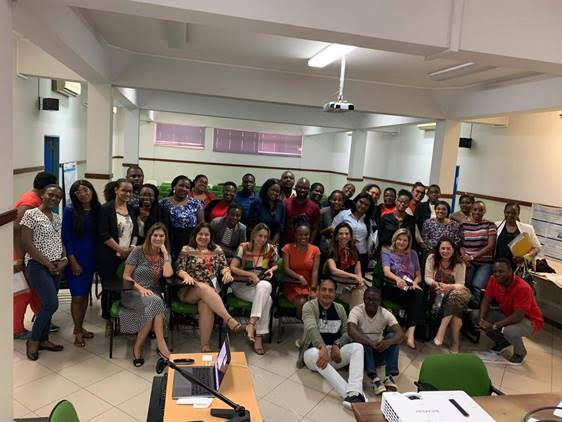- Details
- ICNA
- News
- Hits: 74076
 The ICNA congratulates Professor Lieven Lage on being awarded the Aicardi Lecture 2019 for his contributions to child neurology.
The ICNA congratulates Professor Lieven Lage on being awarded the Aicardi Lecture 2019 for his contributions to child neurology.
The biennial Aicardi Award established by the European Paediatric Neurology Society (EPNS) in partnership with MacKeith Press recognises a respected and admired doctor who has attained major achievements in child neurology. Recipients of the award must practice in Europe using the countries in the WHO European region. The 2029 award presentation and lecture took at the EPNS Congress in Athens on 17 September 2019.
Professor Lagae gave the Aicardi Lecture on the " Miss Understanding is the Greek Goddess of Clinical Research" where he talked about the problems, challenges, successes and failures of clinical research in paediatric neurology.
Lieven Lagae is the current treasurer of the International Child Neurology Association and immediate past President of the European Pediatric Neurology Society He chairs the Taskforce on Medical Treatment of Childhood Epilepsy of the International League against Epilepsy (ILAE). From 2004 to 2015, he was the Editor-in-Chief of the European Journal of Paediatric Neurology. In 2017, he was the recipient of the ‘Cures within Reach patient impact Clinical Award’ and
Dr Lagae is well recognized within theICNA for his contributions to research in child neurology particularly in the area of early onset, drug resistant epilepsies, his strong supportof education and his advocacy of child neurology. He has extraordinary clinical acumen and has a very holistic approach to the management of epilepsies with particular attention to the comorbidities affecting cognition and behaviour.
Professor Lagae has exceptionally broad research interests including the genetic contributions to epilepty, novel treatments and management of comorbidities. He has published over 300 peer reviewed articles as well as numerous book chapters. He is also the editor the MacKeith Press (2017)Book on Cognition and Behaviour in Childhood epilepsy. He serves in many editorial boards of epilepsy and neurology journals including the Journalof the International Child Neurology Association (JICNA). He was also the recipient of the 2017 ‘Cures within Reach patient impact Clinical Award’.
Professor Lagae and his group were integral in evaluating fenfluramine in Dravet sydnrome. He is a very active participant in multicenter studies and has been an exemplary mentor for younger trainees. He has held numerous leadership roles and is a long standing member of the ICNA Executive Board. He has also been an active participant in working groups through the ILAE.
Current epilepsy research projects include the translational research in Zebrafish models of epilepsy, new anti-epileptic drugs in childhood epilepsy and especially in Dravet syndrome, brain stimulation in childhood epilepsy and preventive treatment of epilepsy in tuberous sclerosis complex.
Source: EPNS
With additional contribution from Elaine Wirrell MD
Read More

- Details
- Shesy Rawther
- News
- Hits: 83408
 Pediatric Epilepsy Training (PET) Brasil delivered a Portuguese PET1 course in Luanda (Angola) on Sept 14th 2019. 6 Brazilian staff with expertise in epilepsy were present and the course was delivered free of charge to 34 attendees split into 5 subgroups of 8 attendees each along with one course director.
Pediatric Epilepsy Training (PET) Brasil delivered a Portuguese PET1 course in Luanda (Angola) on Sept 14th 2019. 6 Brazilian staff with expertise in epilepsy were present and the course was delivered free of charge to 34 attendees split into 5 subgroups of 8 attendees each along with one course director.
Among all subscribers, 3 pediatricians from Maputo/Mozambique were registered. ILAE/ICNA provided funding of $5000 which helped bring two of them from Maputo to Luanda.
The staff carried 40 Course Handbooks, folders, badges, pre-course and post-course quiz, evaluation forms and certificates.
Dr Manuel Leite Cruzeiro was an excellent host and provided facilities such as venue with projectors, catering (welcome coffee, two coffee-breaks and lunch) and transportation for the staff.
Epilepsy affects 50-60 million people around the world and one of the most important peaks of incidence is during childhood. This incidence is higher in middle and low-income countries, such Brazil (estimated incidence of 1.5-2%). Most children with epilepsy are assisted by pediatricians or general physicians with limited training in the management of childhood epilepsy. Therefore, the level of care is insufficient in several countries. The PET program attempted to overcome this failure.

Read More
- Details
- Shesy Rawther
- News
- Hits: 7019
A 3 day residential EEG course (EEG in the First Year of Life- from newborn to toddler) will be held from 6-8 March 2020 in Kerala, India.
The content covers normal maturational aspects, abnormal EEG patterns and graphoelements in neonates and infants as well as the range of seizures and epilepsies encountered in day to day practice in the first year of life. It consists of a standardized teaching module with lectures and practical workshops during which EEG examples will be reviewed by participants in small groups under the supervision of a faculty tutor.
The course is targeted at neurologists (paediatric and adult), clinical neurophysiologists, and neonatologists who deal with neonates and infants with seizures or epilepsy.
Limited bursaries are available!
More information can be found on : https://www.ilae.org/congresses/eeg-in-the-first-year-of-life1
Read More
- Details
- Shesy Rawther
- News
- Hits: 2424

Proposals are welcome for the Breakfast Symposia, Junior Member Seminars, and Parallel Seminars. Click here to View the 2020 Scientific Program Proposal Submission Guidelines and Apply!
Deadline : Extended to 15th November 2019
Take note of other important dates and deadlines here below :

Read More
